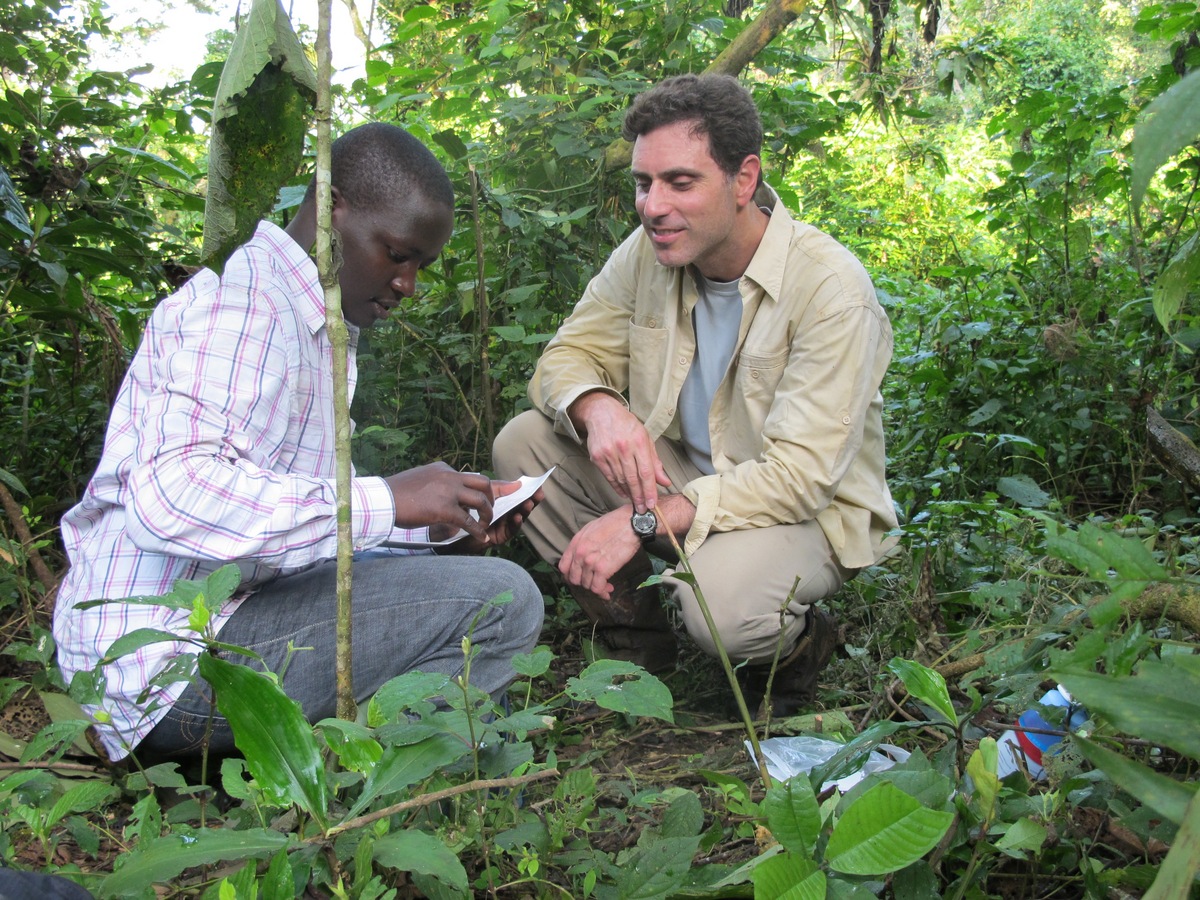UW scientist sniffs out possible new tick species

Tony Goldberg and student Alex Tumukunde look for ticks on the forest floor of Kibale National Park in Uganda.
Photo: James Jones
In June 2012, Tony Goldberg returned from one of his frequent trips to Kibale National Park, an almost 500-square-mile forest in western Uganda where he studies how infectious diseases spread and evolve in the wild. But he didn’t return alone.
“When I got back to the U.S., I realized I had a stowaway,” says Goldberg, professor of pathobiological sciences at the UW–Madison School of Veterinary Medicine and associate director for research in the UW–Madison Global Health Institute. “When you first realize you have a tick up your nose, it takes a lot of willpower not to claw your face off.”
But Goldberg is an old pro when it comes to nose ticks (this was not his first) and, after all, scientists are trained to be objective and rational. He calmly removed the tick with the aid of a long forceps, flashlight, and mirror, and put it in the freezer in a sealed tube to await further study.

Goldberg says the ticks may have developed a knack for attaching to chimps’ nostrils to better avoid being “groomed off.”
Photo: Andrew B. Bernard
Thankfully, the tick was intact enough post-yanking for DNA sequencing, a process that determines the exact order of nucleotides in a DNA molecule — the genetic signature of a living organism. Goldberg worked with Sarah Hamer, a colleague at Texas A&M University, to sequence the tick’s DNA and consulted with Lorenza Beati-Ziegler, curator of the U.S. National Tick Collection at Georgia Southern University, and neither could match the sequence with any species of tick in any database.
“Either it’s a species of tick that is known but has never been sequenced, or it’s a new species of tick,” says Goldberg, who chronicled the discovery with his co-authors in the current (Sept. 30, 2013) online issue of the American Journal of Tropical Medicine and Hygiene.
Goldberg’s stowaway is not the first documented case of a Ugandan nose tick hitching a ride with humans, and others have speculated that these ticks normally infest chimpanzees, which are common in the park. Intrigued, Goldberg enlisted the help of Richard Wrangham, a Harvard University chimp expert, to investigate further. Wrangham and colleagues had just begun using high-resolution digital photography to safely study the timing of molar eruptions in baby chimps from a distance. A closer look at his photos revealed ticks lodged in one-fifth of the chimps’ noses.
Digging deeper, Goldberg determined through a review of previously published studies that his international hitchhiking nose tick, and likely those of the chimps, are of the genus Amblyomma. “Amblyomma are known disease carriers, so this could be an underappreciated, indirect, and somewhat weird way in which people and chimps share pathogens,” says Goldberg.
“When I got back to the U.S., I realized I had a stowaway. When you first realize you have a tick up your nose, it takes a lot of willpower not to claw your face off.”
Tony Goldberg
And this is why studying the ticks is important. According to Goldberg, given that a tick of this sort can avoid detection through an international flight, coupled with the frequency of global travel, it’s possible they could establish exotic tick populations and spread disease to other countries.
Goldberg has spent a large portion of his life in Wisconsin, where wood and deer ticks are abundant, but he has never heard of anyone having a tick up their nose. So why would ticks in the forests of Africa evolve to embed themselves in chimp nostrils? Goldberg surmises that it may have a lot to do with chimp grooming habits.
“Chimps are highly intelligent and social,” says Goldberg. “Above all else, grooming is what they use to bond their society. They’re absolutely nuts about it.”
The ticks may have developed a knack for nostril-diving to better avoid being “groomed off.” As a precedent for this behavior, Goldberg points to a species of chimp louse that, when exposed to light, will stiffen, thrusting its front legs straight forward and rear legs back. It may do this to make itself resemble a piece of debris when chimp hair is parted during grooming in an effort to avoid detection, he says.
“Infectious disease and immunology researchers often look at how viruses and other pathogens avoid the complex immune system inside a host,” says Goldberg. “This is paralleled on a macro scale with ectoparasites, which have apparently evolved mechanisms to counter external host defenses, such as grooming. So it’s not just a tick up my nose — there’s a lot of depth to this.”
Goldberg is still unsure if his nose tick is a new species. Sadly, the specimen he removed was a nymph, rather than full-fledged adult, so he could not identify it by its morphological features. He also has yet to determine the species of the chimp ticks.
“It’s not really practical or safe to pick ticks out of chimps’ noses,” says Goldberg. “The chimps of Kibale are very well habituated to humans, but they would still object vigorously.”
So the next step is attempting to catch ticks on the forest floor with traps, which so far have proven unsuccessful due to chimp interference. While this is disappointing, Goldberg is happy to have at least published his findings up to this point.
“When you get a tick up your nose, you tell the story,” says Goldberg.


